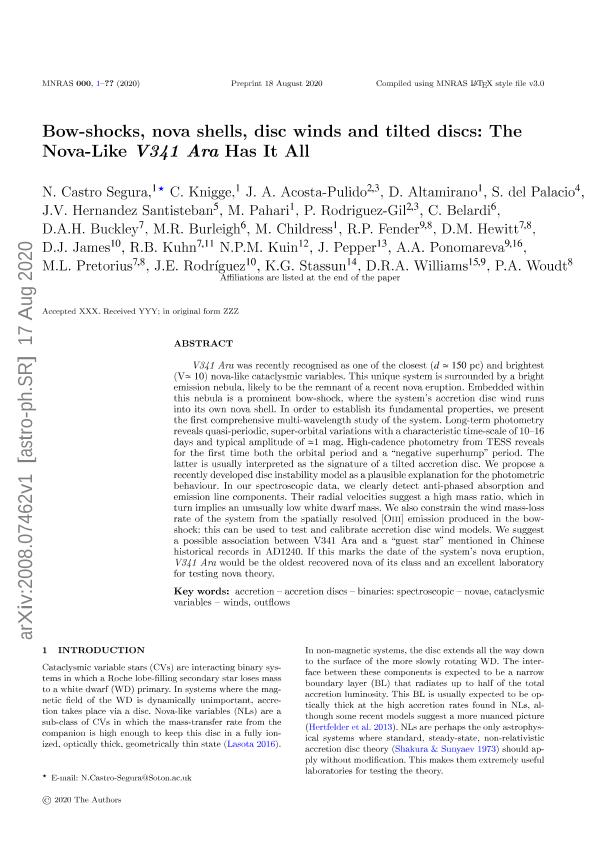Artículo
Bow shocks, nova shells, disc winds and tilted discs: The nova-like V341 Ara has it all
Castro Segura, N.; Knigge, C.; Acosta Pulido, J. A.; Altamirano, D.; del Palacio, Santiago ; Hernández Santisteban, Juan V.; Pahari, M.; Rodriguez-Gil, P.; Belardi, C.; Buckley, D. A. H.; Burleigh, M. R.; Childress, M.; Fender, R.P.; Hewitt, D. M.; James, D.J.; Kuhn, R.B.; Kuin, N.P.M.; Pepper, J.; Ponomareva, A. A.; Pretorius, M. L.; Rodríguez, J.E.; Stassun, K. G.; Williams, D. R. A.; Woudt, P. A.
; Hernández Santisteban, Juan V.; Pahari, M.; Rodriguez-Gil, P.; Belardi, C.; Buckley, D. A. H.; Burleigh, M. R.; Childress, M.; Fender, R.P.; Hewitt, D. M.; James, D.J.; Kuhn, R.B.; Kuin, N.P.M.; Pepper, J.; Ponomareva, A. A.; Pretorius, M. L.; Rodríguez, J.E.; Stassun, K. G.; Williams, D. R. A.; Woudt, P. A.
 ; Hernández Santisteban, Juan V.; Pahari, M.; Rodriguez-Gil, P.; Belardi, C.; Buckley, D. A. H.; Burleigh, M. R.; Childress, M.; Fender, R.P.; Hewitt, D. M.; James, D.J.; Kuhn, R.B.; Kuin, N.P.M.; Pepper, J.; Ponomareva, A. A.; Pretorius, M. L.; Rodríguez, J.E.; Stassun, K. G.; Williams, D. R. A.; Woudt, P. A.
; Hernández Santisteban, Juan V.; Pahari, M.; Rodriguez-Gil, P.; Belardi, C.; Buckley, D. A. H.; Burleigh, M. R.; Childress, M.; Fender, R.P.; Hewitt, D. M.; James, D.J.; Kuhn, R.B.; Kuin, N.P.M.; Pepper, J.; Ponomareva, A. A.; Pretorius, M. L.; Rodríguez, J.E.; Stassun, K. G.; Williams, D. R. A.; Woudt, P. A.
Fecha de publicación:
02/2021
Editorial:
Wiley Blackwell Publishing, Inc
Revista:
Monthly Notices of the Royal Astronomical Society
ISSN:
0035-8711
Idioma:
Inglés
Tipo de recurso:
Artículo publicado
Clasificación temática:
Resumen
V341 Ara was recently recognized as one of the closest (d~ 150 pc) and brightest (V~10) nova-like cataclysmic variables. This unique system is surrounded by a bright emission nebula, likely to be the remnant of a recent nova eruption. Embedded within this nebula is a prominent bow shock, where the system´s accretion disc wind runs into its own nova shell. In order to establish its fundamental properties, we present the first comprehensive multiwavelength study of the system. Long-term photometry reveals quasi-periodic, super-orbital variations with a characteristic time-scale of 10-16 d and typical amplitude of ~1 mag. High-cadence photometry from theTransiting Exoplanet Survey Satellite (TESS) reveals for the first time both the orbital period and a ´negative superhump´ period. The latter is usually interpreted as the signature of a tilted accretion disc. We propose a recently developed disc instability model as a plausible explanation for the photometric behaviour. In our spectroscopic data, we clearly detect antiphased absorption and emission-line components. Their radial velocities suggest a high mass ratio, which in turn implies an unusually low white-dwarf mass. We also constrain the wind mass-loss rate of the system from the spatially resolved [O iii] emission produced in the bow shock; this can be used to test and calibrate accretion disc wind models. We suggest a possible association between V341 Ara and a ´guest star´ mentioned in Chinese historical records in AD 1240. If this marks the date of the system´s nova eruption, V341 Ara would be the oldest recovered nova of its class and an excellent laboratory for testing nova theory.
Archivos asociados
Licencia
Identificadores
Colecciones
Articulos(IAR)
Articulos de INST.ARG.DE RADIOASTRONOMIA (I)
Articulos de INST.ARG.DE RADIOASTRONOMIA (I)
Citación
Castro Segura, N.; Knigge, C.; Acosta Pulido, J. A.; Altamirano, D.; del Palacio, Santiago; et al.; Bow shocks, nova shells, disc winds and tilted discs: The nova-like V341 Ara has it all; Wiley Blackwell Publishing, Inc; Monthly Notices of the Royal Astronomical Society; 501; 2; 2-2021; 1951-1969
Compartir
Altmétricas



